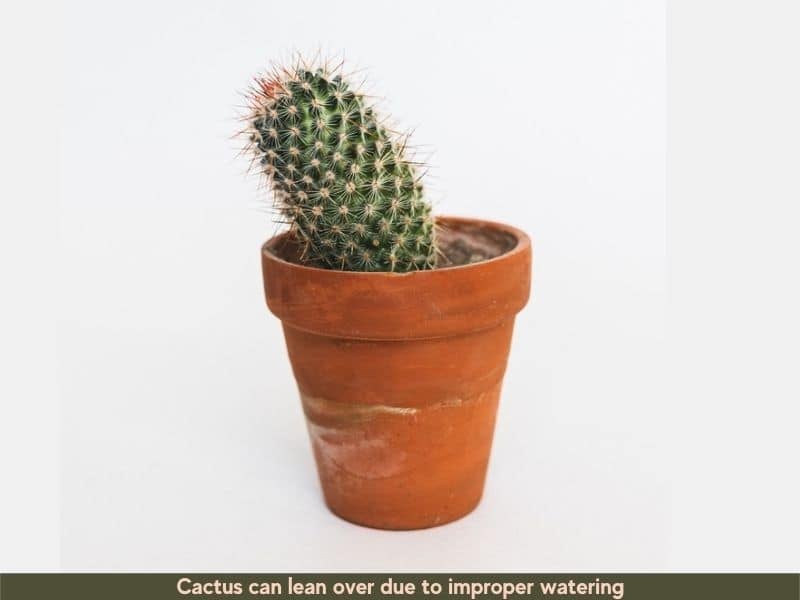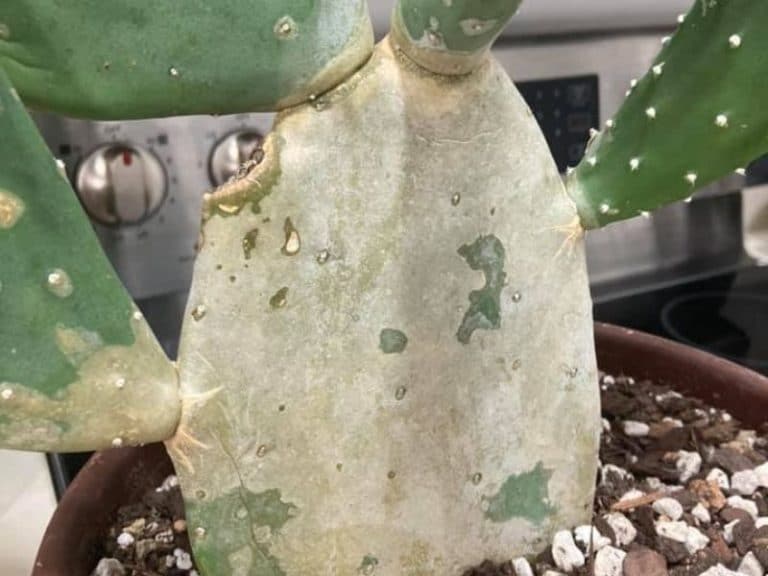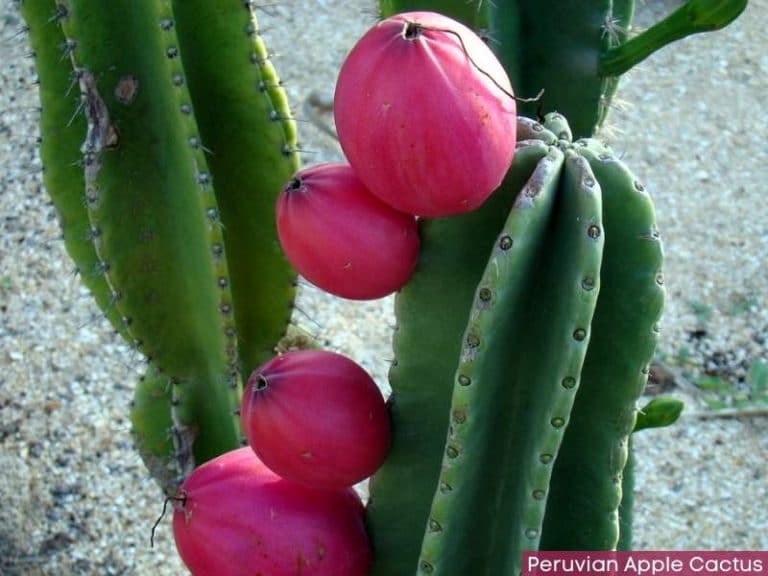Cactus Leaning and Falling Over: Causes and Fixes
A cactus is a low-maintenance plant that can survive harsh conditions but doesn’t make it immune to stress. Drooping and falling over the pot are signs something is wrong with your succulent.
So, what causes the plant to lean, and how do you fix it?
A cactus plant leaning and falling over is a sign of overwatering, underwatering, pest damage, root rot disease, or an oversized pot. Repot the succulent in a container that leaves only 2 inches of space on the sides, then water it when the top 2 inches of soil is dry to improve its strength.

Contents:
Why is my cactus leaning or falling over?
A healthy cactus plant should grow at a 90-degree angle to the soil, signifying that it’s getting the right amount of nutrients and growing in the right environment. However, the plant can look healthy, yet it’s leaning away from the sun. Before coming up with a solution to fix your bending plant, you need to determine how it happened in the first place.
Drooping or sagging can be a sign of pest infestation, insufficient water, and sunlight, freeze damage, and many other conditions.
Here are the reasons for leaning and falling over in cacti:
Root rot disease
Root rot is caused by fungal infection and bacteria, often when a cactus plant is overwatered, leading to drooling. Examine the spot with the infection to determine if the leaning over is due to root rot. If it is mushy, slimy, and dark-colored starting from the base, it’s time to create an appropriate treatment plan for your plant.
When left untreated, a rotting cactus may eventually keel over and die. The only way to save it is by uprooting the plant, treating the infected part with fungicide, and replanting it in new soil.
Pest infestation
Cactus mealybugs, ants, and other pests suck sap from the stems and leaves of cactus plants, causing them to look sickly, deformed, and leaning over. The pests can eat up the plant, making it more prone to fungal infection, and may eventually die.
If you notice bugs or insects around your plant, look for an effective pest extermination solution to prevent and kill them.
Insufficient light
If you’ve studied the native habitat of a cactus plant, you’ll notice that it thrives in bright light and heat. They’re adapted to high heat and light intensity. However, a cactus species grown as a houseplant might not be strong enough to withstand prolonged periods of heat.
Still, it needs adequate sunlight to grow upright and strong. A plant that leans away from the sun may droop even if there are no visible pests or is watered correctly.
Damage from freezing temperatures
The first sign of cactus plant drooping due to freezing damage is the blackening of the exposed parts. The blackening may worsen to wiltedness after a few weeks. It’s common for these plants to get stressed during winter.
Your plant may grow out of the problem as the temperatures keep rising. Preventing freeze damage in succulents involves placing the pot in radiated heat if you’re planting it outdoors. Alternatively, you can cover it with a cotton sheet to keep the plant warm.
The pot is too big
Ideally, a cactus needs a container that’s neither too big, which makes its roots struggle for nutrients and water nor a container too small, denying its roots the space to grow. A big container prevents it from absorbing enough water, leading to droopiness. The standard size of the pot should allow 1-2 inches at the bottom. As the plant grows, repot it every 1-2 years.
Overwatering and underwatering
A cactus should be watered twice a month during summer, parts of fall and spring, and only once a month during winter. The first signs of an underwatered cactus plant are weak stems that droop and turn color from green to purple. While it’s important to minimize watering in winter, you shouldn’t stop watering altogether because the plant transpires even in cooler conditions.
An overwatered cactus may droop and develop root rot due to soil sogginess. The first sign is a soft stem and leaves that turn bright green. This often happens if it’s growing in slow-draining soil and a pot without holes for easier drainage.
How to fix and straighten a leaning cactus?
Making a cactus grow upright again is easy, provided you establish what caused the leaning over in the first place. Here is how to go about it:
1. Water the cactus when the top 1-2 inches of soil is dry
Before giving it water, perform the soil dryness test by sticking your finger in the 1-2 inches of the topsoil. If it’s dry, then it’s okay to water it. If it still feels damp despite watering it more than three weeks earlier on, then the soil and type of container could be retaining the water and causing the plant to lean over.
Solve this by potting it in a terracotta pot which drains water faster. If the soil has slow-draining properties, get cactus soil with sand-like properties.
2. Get rid of pests on foliage and roots
Whenever you spot a mealybug or an ant near the container or perching on your plant, you can kill it by hand. But it would be best to buy an insecticidal soap to kill an adult bug and its newly hatched eggs.
You can rinse off the plant in a concentrated liquid dish soap solution with water. This solution works effectively if the bug or insect hasn’t caused too much damage beyond just drooping cactus leaves.
3. Repot the cactus in a well-sized pot
Once every two years, repot your plant in a pot that will allow a small amount of space from both sides. An ideal container for a cactus plant should be 1-2 inches on the sides and the bottom. This gives the plant enough space to grow and benefit from water and nutrients found in the soil.
4. Provide 6-12 hours of sufficient light
Mimicking the native habitat of a cactus plant is one of the critical ways of correcting droopiness. If you initially placed it in a dark room, rehome it in a room that receives sufficient light.
Alternatively, you can move the pot outdoors in your patio or terrace to allow it to receive at least 12 hours of light and stop leaning over for light. Once its uprightness is restored, bring it indoors but in a room with sufficient light.
5. Keep the cactus warm during freezing months
Since cacti hibernate during winter, keeping them warm after noticing that the freezing temperatures make them droop is important. It’s either you put it in a location with radiated heat at night or cover it with a cotton sheet for extra warmth.
How to prevent cacti from growing curved
Whether it’s your first time planting a cactus plant or have a plant that’s recovering from droopiness, knowing how to care for it is essential. Therefore, apply these simple tips:
- Get the right-sized container– After every two years, you’ll need to repot your cactus in a container with 1-2 inches of space on the sides.
- Ensure your cactus gets adequate sun– You can place the pot outdoors for the plant to receive at least 12 hours of light. Ensure your plant isn’t placed in a location that allows other plants to compete with it for sunlight.
- Give it water only when the top 1-2 inches of soil is dry. Your watering pattern should vary. For example, you can water it after 5-6 weeks in winter and twice a month during summer.
- Get rid of mealybugs or any other insects using an insecticide.






